Homebase and QuickBooks are both good workforce management platforms, but one’s better for single-location businesses on tight budgets, while the other is better for mobile workforces.
Workforce management systems help employers save time, reduce mistakes, and skip the manual hassle of tracking workers’ hours, scheduling shifts, and running payroll.
But with so many platforms out there, it’s hard to know which ones are worth your while. Pick the wrong one, and you could waste resources, frustrate your team, and end up back at square one.
Below, I compare 2 top picks, Homebase vs. QuickBooks, side-by-side, so you can choose the right one for your needs.
A note about our method: All product comparisons and verdicts in this guide are based on hands-on testing by our expert team. All screenshots are original and were taken during actual tests.
At a Glance: Quick Summary
Homebase is a time tracking, scheduling, and payroll solution that’s excellent for hourly or shift-based businesses. It also offers in-app messaging, hiring, and employee engagement tools, which is great if you’re looking for a more comprehensive toolkit.
However, Homebase offers payroll only as an add-on, so it can get costly. Plus, it charges companies per location, making it pricey for multi-location businesses.
QuickBooks offers time tracking, scheduling, and payroll through QuickBooks Time. It’s a great integrated solution for businesses already using QuickBooks Online for accounting and invoicing, and also offers mileage tracking features that work well for mobile or field businesses.
Unfortunately, QuickBooks lacks self-service tools like shift swapping, and its fixed platform fee makes it an expensive option.
Pricing and Plans
Here’s what Homebase and QuickBooks cost for their core workforce management plans.
| Plan Type | Homebase | QuickBooks |
| Basic |
Basic $0/month
|
Time Premium* $20/month platform fee + $8/user/month (1 admin limit)
|
| Next Tier |
Essentials $24/location/month (unlimited employees)
|
Time Elite* $40/month platform fee + $10/user/month (1 admin limit)
|
| Plus / Premium |
Plus $56/location/month (unlimited employees)
|
Time Premium + Payroll Premium $85/month platform fee + $9/user/month
|
| Ultimate |
All-in-one $96/location/month (unlimited employees)
|
Time Elite + Payroll Elite $130/month platform fee + $11/user/month
|
| *All prices show the monthly cost when billed annually as of July 2025. | ||
Homebase offers a free plan for businesses with a single location and fewer than 10 employees, which I really appreciate. But the per-location model can get pricey as you grow and branch out to multiple locations. Additionally, payroll costs extra across all plans, even the All-in-one plan, which I think feels a bit sneaky.
QuickBooks charges a fixed platform fee plus a per-user fee across all plans. This can quickly add up, especially for larger teams. That said, at the time of writing, the platform offers a discount for the first 3 months.
The lower-cost, time-only plans are available only for QuickBooks Online users, who already pay $19/user/month for a basic QuickBooks Online plan (QuickBooks Online plans with time tracking included start at $28/user/month). Other companies must opt for one of the higher-cost time tracking + payroll plans.
Overall, Homebase is a strong choice if you’ve got only a few locations or want a comprehensive solution with hiring, messaging, and more. But QuickBooks is better if you’re already a QuickBooks Online customer or want to avoid hidden costs.
Pros and Cons
Let’s look at the main pros and cons for each platform.
Homebase pros ✅
- Free plan for small businesses with up to 10 users in a single location
- Comprehensive offering includes hiring and communication
Homebase cons ❌
- Payroll available only as an add-on
- Doesn’t include any project or task management tools
QuickBooks pros ✅
- Seamlessly integrates with QuickBooks Online for accounting and invoicing
- Mileage tracker is great for teams on the move
QuickBooks cons ❌
- No free plan, so might not be a great choice for businesses on budgets
- No shift-swapping tools, so scheduling becomes an admin-heavy task
Use Cases
Despite offering similar solutions, each platform stands out for different reasons.
Homebase is best for:
- All-in-one team management: In addition to workforce management, Homebase offers team messaging, hiring tools, and plenty of third-party integrations. It’s a great choice if you want to manage most of your processes from a single platform.
- Scheduling shifts: Homebase lets you create and assign shifts manually or use smart scheduling, open shifts, and shift swapping based on workers’ availability and your budget to save time and reduce errors.
QuickBooks is best for:
- Time verification and employee monitoring: Features like geofencing (virtual boundaries that restrict where employees can clock in), photo timesheets, mileage tracking, and “see who’s working” are great ways to prevent time theft and keep mobile teams accountable.
- Compliance and taxes: QuickBooks offers full-service payroll, including automating payroll filings and reporting, built-in alerts, and support to avoid tax penalties. It also integrates seamlessly with QuickBooks’ accounting platform.
Side-by-Side Feature Overview
Let’s look at Homebase and QuickBooks’ features side-by-side.
Time tracking and verification – Winner: QuickBooks

Both platforms enable you to track not just regular work hours but also breaks and overtime.
With Homebase, employees can clock in and out of work and rest breaks using any device, including their desktops, tablets, smartphones, and POS systems. And, they can add hours manually if needed. You can set geofences, capture clock-in locations, mandate photo verification, and get overtime alerts to prevent time theft and buddy punching. However, these aren’t available on the Basic plan.
QuickBooks also lets workers punch in and out of work and breaks from their desktops and mobile devices, and you can set up a kiosk for teams operating from shared locations. Unfortunately, we experienced a glitch when testing the overtime feature.
We used the built-in California overtime rules and left the timer running for more than 26 hours. The platform didn’t record overtime or double-time hours.
During testing, we noticed this issue in the timesheet approval flow. This is something worth double-checking if your business depends on accurate overtime calculations, as this problem could lead to serious payroll errors.
Still, I think QuickBooks’ range of verification tools is impressive. In addition to geofencing and photo verification, you can also track workers’ live locations. This, I think, puts it a step above Homebase for mobile teams.
Timesheets and payroll – Winner: QuickBooks
Homebase turns logged hours, including PTO and breaks, into ready timesheets that you can view, edit, approve, and sync with built-in payroll in a single click or export to integrated third-party solutions. The platform also supports tax filings, W-2 and 1099 reporting, and lets employees cash out up to $400 in early wages (with no risk to you). I think these cash advances could help reduce financial stress for employees and improve retention, especially among hourly or lower-wage staff.
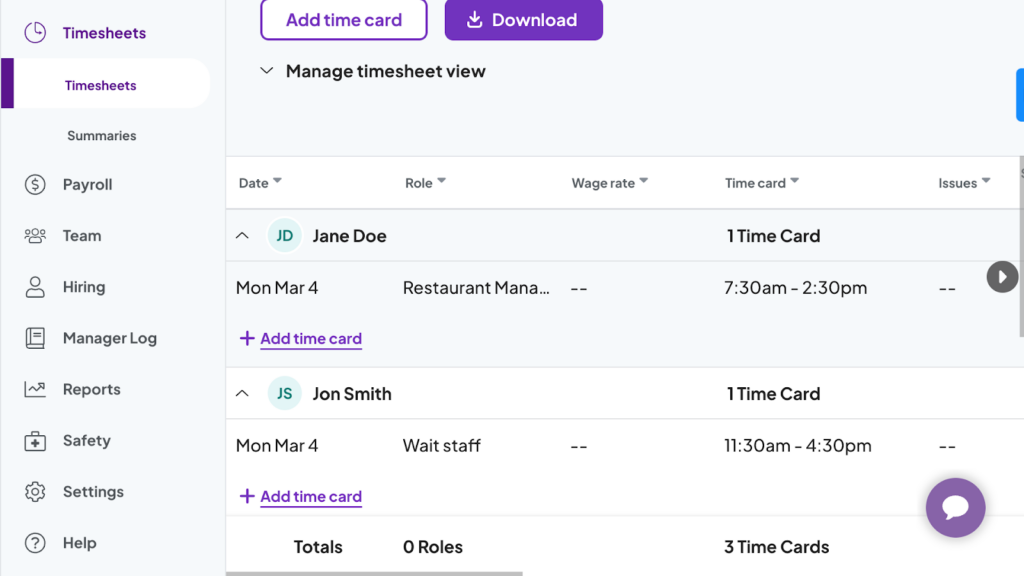
QuickBooks also uses timesheets to auto-generate timesheets, and lets you review and approve these from your dashboard. You can integrate timesheets with third-party solutions or run payroll on QuickBooks, which also offers tax filing and compliance reporting, and can protect you for up to $25,000 in tax penalties. I also like that you can sync wage reports with QuickBooks Online for integrated accounting.
Because Homebase offers payroll as a paid add-on, which I think is a huge miss, it doesn’t win here. But you can integrate it with third-party payroll solutions if preferred.
Shift scheduling – Winner: Homebase

Homebase lets you build schedules from scratch, reuse previous ones, and create templates for recurring shifts. You can also opt for auto-scheduling, which optimizes shifts based on your needs, staff availability, and labor budgets. I was very impressed by this. Employees can also pick from open shifts or swap if something comes up, reducing some of your admin load.
QuickBooks’ drag-and-drop tools make it easy to create and assign shifts. While you can add shift details and notify employees of changes, there’s no auto-scheduling or employee self-service tools. The feature is basic and puts more of the onus on admins. I also think the lack of employee self-service tools will frustrate staff who want more visibility and control over their schedules. This is why Homebase comes out on top for me in this category.
Time off management – Winner: Homebase
Homebase lets you set custom PTO policies based on your location and company culture. You can track accruals, limit time off on blackout dates, and mandate advance notice for time off requests.
Employees can submit requests and view their PTO balances via their app, and you can view leave balances and a team-wide PTO dashboard to make decisions before approving or denying requests from your dashboard. My only complaint? These features are locked behind higher-tier plans.
QuickBooks lets workers view their balances and request time off through their apps. You can adjust settings to skip approvals if preferred and even add bulk time off data into the app, which is useful if you’ve given everyone time off for a specific reason, like celebrating a company milestone.
Otherwise, you can respond to requests via your dashboard. While QuickBooks provides the essential tools, I found Homebase’s offering stronger—for instance, QuickBooks doesn’t enable blackout dates.
HR and compliance – Winner: QuickBooks
Homebase offers tools to manage employee documents, track licenses and certifications, run background checks, and create custom handbooks for your company.
You can also set rules for breaks, overtime, and PTO to stay compliant with labor laws. Finally, you can chat with certified HR pros when you need additional support.
QuickBooks offers built-in HR tools through its partnership with Mineral. You can talk to certified HR advisors, access state and federal compliance updates, and use templates to create job descriptions, handbooks, and onboarding checklists.
Importantly, QuickBooks also offers access to benefits, such as health insurance, 401(k), and workers’ comp insurance. This puts it above Homebase, in my opinion.
Additional features and integrations – Winner: Tie

Homebase offers several additional work management tools, including hiring and onboarding. With its built-in applicant tracking system, you can post jobs, track candidates, and send new hire documents, all from one place. I was also a big fan of the in-app messenger, which lets you share updates and notes instantly. That said, I was disappointed that the chat doesn’t support images or file-sharing.
QuickBooks also offers additional features, but these are more relevant to field and frontline teams, which is why I prefer it. You can create projects, set budgets, track labor costs vs. budgets, and build invoices through QuickBooks Online. Additionally, mileage tracking ensures mileage is automatically and accurately logged, which is great for monitoring teams on the move. But I wish the app had messaging capabilities.
Reporting – Winner: QuickBooks
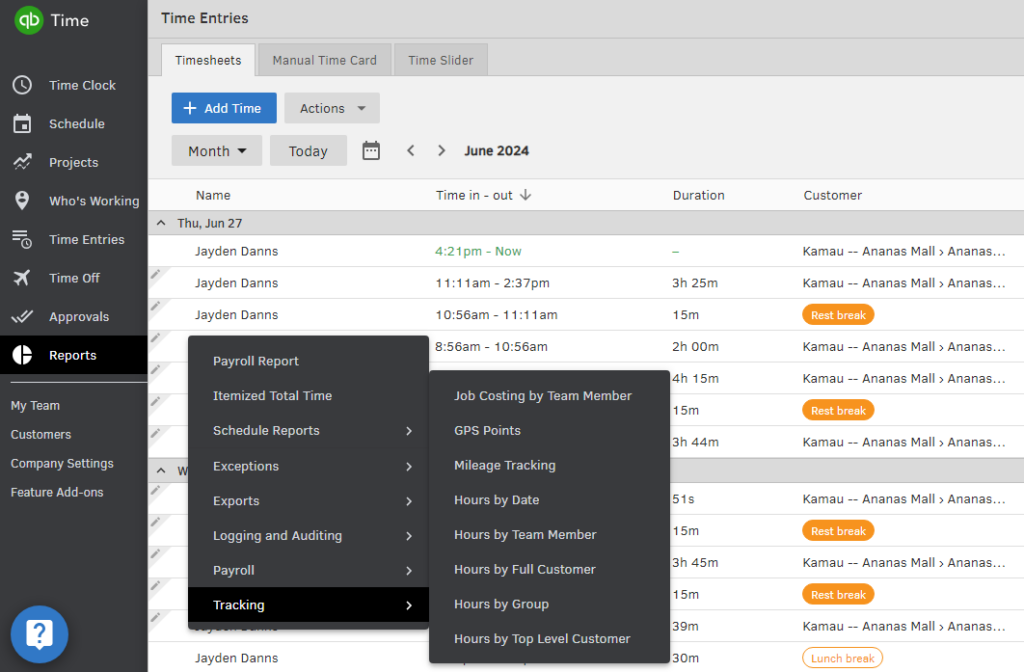
Homebase offers ready reports on hours worked, labor costs, attendance, and shift feedback. You can see real vs. scheduled hours, late clock-ins, and even certification expiration dates. Unfortunately, you can’t build custom reports or filter by time ranges. Additionally, only a few reports can be exported or printed, which I didn’t like.
QuickBooks gives you more filters and ready reports like job costing, payroll, and GPS data. But when we tested it, the app was missing a real-time analytics dashboard. Still, I think it wins in this category because it lets you create custom reports and drill into granular data like labor costs and mileage.
Usability – Winner: QuickBooks
Homebase is clean, simple, and easy on the eyes. When I tested it, I loved how it didn’t feel overwhelming. The layout is intuitive, with most features listed neatly in the sidebar, though a few key tools like the in-app chat and time tracking are slightly harder to spot. Moreover, there’s no offline time tracking or accessibility tools for those with impairments.
QuickBooks is also easy to navigate and has a helpful setup wizard for additional support. However, during testing, we found that the web app looks cluttered, and the mobile app occasionally freezes. Despite this, it outshines Homebase because it offers offline time tracking, which is a big win for field teams.
User Ratings
Both platforms are well-rated on popular software review websites. While Homebase’s reviews cover all features, QuickBooks has separate reviews for its time tracking and payroll features, due to how the app was previously set up. QuickBooks Payroll seems to have the lowest rating.
Homebase
⭐ 4.6/5 on Capterra
⭐ 4.3/5 on G2
QuickBooks Time
⭐ 4.7/5 on Capterra
⭐ 4.5/5 on G2
QuickBooks Payroll
⭐ 4.4/5 on Capterra
⭐ 3.7/5 on G2
Security & Compliance
Here’s how the platforms stack up when it comes to privacy and security.
| Feature | Homebase | QuickBooks |
| Data encryption | ✅ | ✅ |
| 2FA/MFA | ✅ | ✅ |
| Access-based controls | ✅ | ✅ |
| Security certifications | ❌ ISO or SOC 2 certifications | ✅ ISO 27001 ✅ SOC 2 |
| Privacy compliance | ❌ HIPAA ❌ GDPR | ❌ HIPAA ✅ GDPR |
Homebase offers basic security and data privacy measures, such as end-to-end encryption, 2FA, and role-based access controls. According to the website, it’s working toward a SOC-2 certification, but hasn’t received it yet. There’s also no mention of GDPR or HIPAA compliance, which I find disappointing.
QuickBooks, on the other hand, offers the same security measures but also has ISO and SOC 2 certifications and GDPR compliance. It doesn’t offer HIPAA compliance, so it may not be the best choice for US healthcare businesses. But it’s better suited than Homebase is for many businesses with higher data protection needs.
Setup and Onboarding
Both platforms are quick and easy to set up.
Homebase has handy prompts to guide you through role-based permissions, setting up your team, and building schedules. You’ll also find pre-built templates and plenty of how-to guides and videos in the help center and on YouTube. It seems like it was built for non-technical users, which works well for several field and frontline businesses.
When I tested the platform, setup was quick for me.
QuickBooks also has a smooth onboarding process. There’s a setup wizard to walk you through setting up company basics. You can add team members using a QR code, no manual entry needed. Setting up individual features like projects, overtime policies, and customers was very straightforward.
When we tested Quickbooks, our tester thought the setup was “smooth sailing” and appreciated how QR codes sped up the process. You can create and share these codes with your workforce, and individuals can use them to create their own accounts, saving you the hassle.
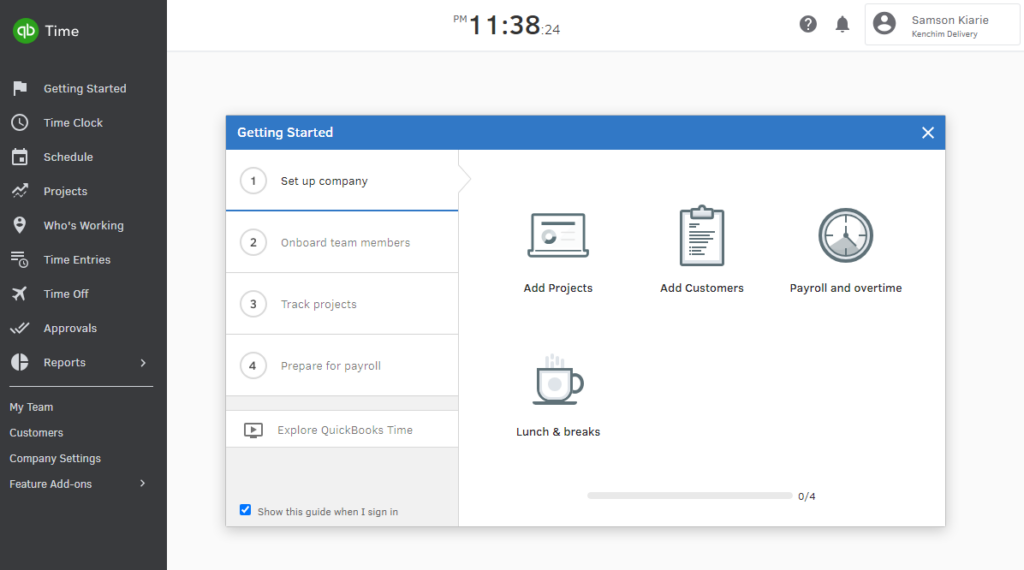
Support and Customer Service
Let’s explore how Homebase and QuickBooks compare in customer support.
| Support | Homebase | QuickBooks |
| Live Chat and Phone | ✅ 8 am–7 pm CST, Monday–Friday | ✅ 6 am–6 pm PT, Monday–Friday |
| Request Form / Email | ✅ | ❌ |
| Help Center | ✅ | ✅ |
| Community Forum | ❌ | ✅ |
While QuickBooks offers live chat and phone support on all plans, Homebase doesn’t include these on the Basic plan. Conversely, Homebase provides an online request form and responds via email, while QuickBooks doesn’t have this option in its toolkit.
Both platforms offer handy online resources, such as how-to guides and video tutorials, and QuickBooks even has a community forum. (That said, when we tested QuickBooks, our tester discovered that its support is shared across all Intuit products, making it harder to find specific help and resources.)
My biggest complaint is that neither provides 24/7 customer support, even on the higher-cost plans. If you ask me, both platforms have room for improvement in this category.
🏆 Who Wins: Homebase or QuickBooks?
| Choose Homebase if you… | Choose QuickBooks if you… |
| Want a comprehensive team management toolkit that includes communication, hiring, and onboarding tools. | Already use QuickBooks Online and want a full integration for time tracking, accounting, and payroll. |
| Need stronger scheduling features like shift swapping and auto-scheduling. | Run a mobile or field business and need access to live GPS monitoring and mileage tracking. |
| Have a small to medium-sized business with a single or handful of locations, or need a free plan. | Have a medium or large business that needs full-service payroll, compliance support, and tax penalty protection. |
| Read our in-depth Homebase review | Read our in-depth QuickBooks Time review |
Our take
Here’s what I think: If you’re looking for a strong time tracking solution with built-in payroll, compliance and tax support, and integrating accounting, QuickBooks is the way to go. Additionally, it’s packed with helpful features like GPS and mileage tracking, which are great for businesses on the move, like delivery and logistics companies or other field businesses.
But if you’re a small business just starting out on a tight budget, or one that values a user-friendly interface and broad set of team tools, Homebase might be a smarter choice. It offers employee self-service tools, hiring, messaging, and more, and works well for companies with few locations.
Ultimately, both are good picks. The right choice boils down to your team’s size, budget, and daily needs.
Connecteam vs. Homebase vs. QuickBooks
As evident, Homebase and QuickBooks are both strong workforce management platforms. But each has certain drawbacks or missing features.
I’ve found that Connecteam, an all-in-one workforce management solution, offers the best of both platforms. It provides nearly every single feature offered across Homebase and QuickBooks, and more, at a fraction of the cost. Furthermore, its user-friendly design, full-featured mobile app, and handy customer support make it stand out as the best product in this space.
Let’s look at how Connecteam’s core features measure up to Homebase and QuickBooks.
| Feature | Connecteam | Homebase | QuickBooks |
| Free plan | ✅ | ✅ | ❌ |
| Time tracking | ✅ | ✅ | ✅ |
| Geofencing | ✅ | ✅ | ✅ |
| Live GPS tracking | ✅ | ❌ | ✅ |
| Mileage tracking | ✅ | ❌ | ✅ |
| Timesheets | ✅ | ✅ | ✅ |
| Payroll support | ✅(multiple integrations) | ✅(only as an add-on) | ✅(only on higher plans) |
| Overtime rules and alerts | ✅ | ✅ (not on Basic plan | ✅ |
| Smart scheduling | ✅ | ✅ | ❌ |
| Shift swapping and open shifts | ✅ | ✅ | ❌ |
| Time off management | ✅ | ✅(only on higher plans) | ✅ |
| HR management | ✅ | ✅ | ✅ |
| Compliance and tax tools | ✅ | ✅ | ✅ |
| Communication features | ✅ | ✅ | ❌ |
| Task / Project management | ✅ | ❌ | ✅ |
| Training and development | ✅ | ❌ | ❌ |
| Third-party integrations | ✅ | ✅ | ✅ |
| ISO 27001 and SOC-2 certifications | ✅ | ❌ | ✅ |
| GDPR compliance | ✅ | ❌ | ✅ |
| HIPAA compliance | ✅ | ❌ | ❌ |
| 24/7 customer support | ✅ | ❌ | ❌ |
Time tracking and payroll
Connecteam’s employee time clock lets workers track their hours with a single click from any desktop, tablet, smartphone, or kiosk. Like Homebase and QuickBooks, you can set overtime rules, alerts, and geofences. But the overtime controls are less glitchy than QuickBooks, and unlike Homebase, Connecteam offers live GPS tracking, which is great for mobile teams.
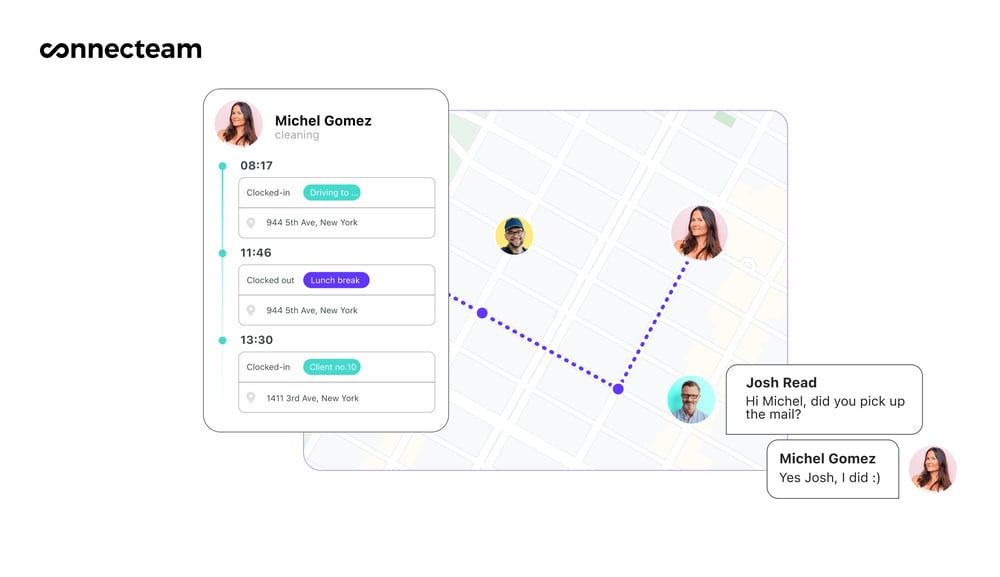
Connecteam uses time logs to automatically generate timesheets for payroll. You can view, edit, and approve these from your dashboard before syncing with one of several popular payroll providers like Gusto, Paychex, ADP, and more. This gives you the flexibility to use a single system while benefiting from the strengths of 2 platforms. Plus, you can pick a payroll partner that fits your needs and budget.
Leave management and shift scheduling
Connecteam’s time off management lets you create custom leave policies, each with its own permitted time off, carryover policy, and accrual rules. Employees can request time off via the app, and you can view leave balances and approve or deny requests from your dashboard.
Unlike Homebase, this feature isn’t restricted to higher-tier plans. But the best part for me is that Connecteam’s time off tools feed into its job scheduling tool. For instance, the smart scheduler assigns shifts based on workers’ preferences, locations, skills, and even time off, which is such a clever way to avoid scheduling errors.
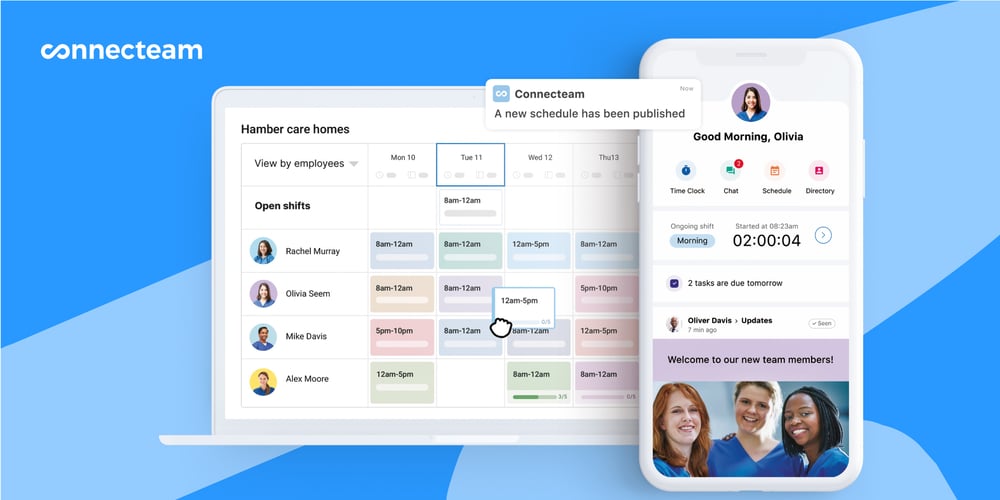
You can also build rest breaks into schedules to stay compliant, and let employees pick from open shifts or swap shifts when needed. This is much more advanced compared with QuickBooks’ basic scheduling tool.
Privacy and security
Connecteam offers all the security and privacy measures Homebase and QuickBooks do. Additionally, it’s got ISO 27001 and SOC-2 certifications and is compliant with both GDPR and HIPAA. Neither of the other platforms covers all of this.
Customer support
Unlike Homebase and QuickBooks, Connecteam provides 24/7 support, even on the free and lower-cost plans. You can receive help in just under 5 minutes.
For additional support, you can pay for Connecteam Pros, who provide 2 services. They can 1) fully set up and customize features for you, and 2) offer tailored training and onboarding. This ensures you can get up and running in no time.
Overall, I think Connecteam’s support is extremely personalized compared with the competition.
Additional features, integrations, and affordability
In addition to workforce management, Connecteam offers task management, internal communications (with image and file-sharing support), training, employee engagement, and HR management—a broader range than both QuickBooks and Homebase. It also integrates with several third-party systems, including QuickBooks’ accounting and invoicing systems.
What’s more, there’s a free trial, a free plan for small businesses, and prices start at $29/month for up to 30 users.
Unlike Homebase and QuickBooks, Connecteam gives you the flexibility to grow without forcing you to pay more per location or locking essential features behind expensive add-ons. If you’re managing a deskless team and want one tool that does it all without the surprises, Connecteam is the best fit.
Get started with Connecteam for free!
FAQs
Is there an app similar to QuickBooks?
Yes, there are several apps similar to QuickBooks depending on your needs. Homebase and Gusto offer time tracking and payroll, while Xero is a good alternative for accounting. If you’re looking for an all-in-one workforce management solution, Connecteam is the best choice.
Is Homebase payroll better than QuickBooks?
It depends on what you’re looking for. Homebase may be a better fit for smaller businesses looking for a free plan and user-friendly design. QuickBooks offers better compliance support, accounting integrations, and tax penalty protection. If you’re already using QuickBooks Online, you’ll benefit from a quicker setup with QuickBooks’ payroll solution.
Does Homebase have a free trial?
Homebase doesn’t have a free trial, but it offers a free plan for businesses with a single location and fewer than 10 users. If you’re looking for an app with a free trial, consider Connecteam, an all-in-one team management platform that offers a 14-day free trial.
Can I use QuickBooks for free?
QuickBooks doesn’t provide a free plan. You can opt for a 30-day free trial through QuickBooks’ pricing page, but you’ll need to provide your credit card details. You can also get 30% off QuickBooks’ payroll platform through Connecteam’s marketplace.

